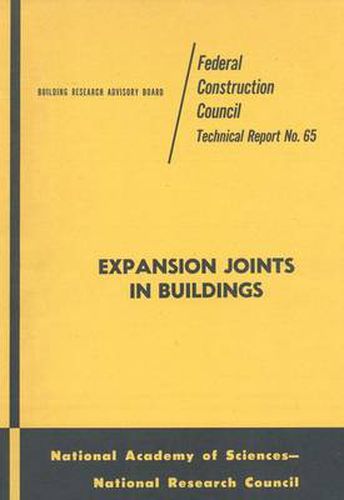Readings Newsletter
Become a Readings Member to make your shopping experience even easier.
Sign in or sign up for free!
You’re not far away from qualifying for FREE standard shipping within Australia
You’ve qualified for FREE standard shipping within Australia
The cart is loading…






Many factors affect the amount of temperature-induced movement that occurs in a building and the extent to which this movement can occur before serious damage develops or extensive maintenance is required. In some cases joints are being omitted where they are needed, creating a risk of structural failures or causing unnecessary operations and maintenance costs. In other cases, expansion joints are being used where they are not required, increasing the initial cost of construction and creating space utilization problems. As of 1974, there were no nationally acceptable procedures for precise determination of the size and the location of expansion joints in buildings. Most designers and federal construction agencies individually adopted and developed guidelines based on experience and rough calculations leading to significant differences in the various guidelines used for locating and sizing expansion joints. In response to this complex problem, Expansion Joints in Buildings: Technical Report No. 65 provides federal agencies with practical procedures for evaluating the need for through-building expansion joints in structural framing systems. The report offers guidelines and criteria to standardize the practice of expansion joints in buildings and decrease problems associated with the misuse of expansions joints. Expansions Joints in Buildings: Technical Report No. 65 also makes notable recommendations concerning expansion, isolation, joints, and the manner in which they permit separate segments of the structural frame to expand and to contract in response to temperature fluctuations without adversely affecting the buildings structural integrity or serviceability.
$9.00 standard shipping within Australia
FREE standard shipping within Australia for orders over $100.00
Express & International shipping calculated at checkout
Many factors affect the amount of temperature-induced movement that occurs in a building and the extent to which this movement can occur before serious damage develops or extensive maintenance is required. In some cases joints are being omitted where they are needed, creating a risk of structural failures or causing unnecessary operations and maintenance costs. In other cases, expansion joints are being used where they are not required, increasing the initial cost of construction and creating space utilization problems. As of 1974, there were no nationally acceptable procedures for precise determination of the size and the location of expansion joints in buildings. Most designers and federal construction agencies individually adopted and developed guidelines based on experience and rough calculations leading to significant differences in the various guidelines used for locating and sizing expansion joints. In response to this complex problem, Expansion Joints in Buildings: Technical Report No. 65 provides federal agencies with practical procedures for evaluating the need for through-building expansion joints in structural framing systems. The report offers guidelines and criteria to standardize the practice of expansion joints in buildings and decrease problems associated with the misuse of expansions joints. Expansions Joints in Buildings: Technical Report No. 65 also makes notable recommendations concerning expansion, isolation, joints, and the manner in which they permit separate segments of the structural frame to expand and to contract in response to temperature fluctuations without adversely affecting the buildings structural integrity or serviceability.